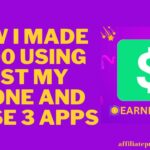Welcome to my article From Zero to Hero: A 30-Day Blogging Challenge for Beginners. Ever dreamed of starting a blog but felt a little… overwhelmed? You’re not alone. Between choosing a niche, figuring out SEO, and wrestling with WordPress themes, it can feel like a full-contact sport. But don’t worry; this isn’t another “sink-or-swim” situation! With a bit of guidance and a day-by-day plan, you’ll go from scratching your head to launching a blog that’s ready to impress in just 30 days.
This 30-day blogging challenge is built for beginners, and we mean true beginners—whether you’re just hearing about “niches” for the first time or have yet to pick a domain name. Think of it as your blogging bootcamp, minus the drill sergeant. Each week, we’ll tackle a specific phase of blogging: from setting up the essentials and brainstorming content to mastering basic promotion techniques and even dipping your toes into monetization. By the end of this month, you’ll have your blog launched, posts published, and maybe even some readers and followers! So grab your caffeine of choice, a notebook (or a stack of sticky notes), and let’s get blogging! If you’re ready to start this adventure, the 30-day challenge is laid out for you below. With small, manageable steps each day, you’ll be surprised at how quickly you can go from zero to blogging hero.
Access My Proven Blueprint for $50-$100 Daily Income – Watch This FREE Video Now >>>

Week 1 – Laying the Foundation: Define Your Blog’s Purpose and Set Up Essentials
Welcome to Week 1! Think of this as the foundation-laying phase for your blog—like setting up the walls and framework of a new home. This week, we’ll make some key decisions that will shape the identity, structure, and look of your blog, so you’re ready to launch it with confidence.
Step 1: Choosing Your Niche
First things first: picking a niche! If the word “niche” makes you think of some obscure specialty, think again. It’s simply about narrowing your blog’s focus to something you’re excited about and your readers will be, too. Think about topics you enjoy, that have depth for consistent content, and that people actually search for. Whether it’s food, personal finance, fashion, or something wildly unique, finding your niche will help guide your content and attract the right audience.
Pro Tip: Check out popular blogs in your potential niches to see what they’re covering and where you might add your unique spin. It’s like doing a little friendly “neighborhood recon” before setting up shop.
Step 2: Selecting a Blogging Platform
Next, it’s time to pick your blogging platform. WordPress, Wix, Blogger—there’s no shortage of options. For beginners, WordPress.org is a popular choice because it offers flexibility, customization, and loads of plugins. However, platforms like Wix and Blogger are also user-friendly and great for folks who want a simpler experience without all the bells and whistles.
Quick Reality Check: If you go with WordPress.org, you’ll need to find hosting (more on that below). Platforms like Blogger and Wix take care of hosting for you but come with a few more limitations.
Step 3: Picking a Domain Name and Hosting
Your domain name is your blog’s “address” on the internet—so make it memorable! Aim for something catchy, relevant to your niche, and easy to spell. Sites like Namecheap or GoDaddy can help you check if your dream name is available, and many hosting platforms offer a free domain with their packages.
Speaking of hosting, this is like renting space on the internet for your blog. Providers like Bluehost and SiteGround offer reliable options for beginners, often with one-click WordPress installations that make setup a breeze.
Step 4: Designing Your Blog
This is the fun part where you get to make your blog visually appealing! Most platforms offer pre-designed themes, and WordPress especially has options for just about any look you can imagine, from minimalist to ultra-fancy. Choose a theme that reflects your blog’s personality but also keeps things clean and easy for readers to navigate.
Pro Tip: If you’re on WordPress, look for themes that are “mobile-responsive” since so many people read blogs on their phones these days.
Step 5: Installing Essential Plugins
Plugins are the secret tools that turn your blog from basic to functional and fabulous. While you don’t need a ton to start, there are a few essentials that can make a big difference:
- SEO Plugin (like Yoast SEO): This helps with search engine optimization, which is key to getting people to find your blog.
- Security Plugin (like Wordfence): Keep those pesky hackers at bay!
- Analytics Plugin: Google Analytics can help you track who’s reading your blog, what they’re clicking, and how long they’re staying—valuable info for any new blogger.
Wrapping Up Week 1
And that’s it for Week 1! By the end of this week, you should have your blog’s niche, platform, domain, and basic setup ready to go. You’re laying down the building blocks of a blog that’s not only functional but also equipped to grow. Next week, we’ll dive into the exciting world of content creation, where you’ll plan and write posts that your audience will love.
So take a deep breath, pat yourself on the back, and get ready for Week 2—you’re already on your way from zero to blogging hero!
Week 2 – Content Creation Basics: Plan and Write Your First Posts
Welcome to Week 2, where we move from laying the foundation to actually creating content—the heart and soul of any blog. This is the week where you start filling that digital blank canvas with posts your readers will love. Don’t worry, you don’t need to churn out Pulitzer-worthy articles right away. The goal is simply to get comfortable with the process of planning and writing, so you’ll have a few solid posts ready to go by launch day.
Step 1: Brainstorm Post Ideas
Let’s start by generating some blog post ideas. Grab a notebook, open a fresh document, or use an app, and start jotting down anything that comes to mind. Think about the type of questions people in your niche might have, trending topics, or even personal stories that relate to your niche. Aim to brainstorm at least 10-15 ideas to give yourself a small pool of options.
If you’re feeling a bit stumped, here are some prompts to kickstart your creativity:
- Listicles (“10 Best Budgeting Tips for New Grads”)
- How-Tos (“How to Bake the Perfect Sourdough at Home”)
- Beginner Guides (“A Beginner’s Guide to Sustainable Living”)
- Personal Stories (“Why I Quit My 9-5 to Travel Full-Time”)
- Reviews (“The Pros and Cons of XYZ Product”)
Pro Tip: Spend a few minutes searching your ideas on Google to see if they’re popular. Look for keywords or questions that people are actively searching for—that’s a sign you’re on the right track!
Step 2: Create a Content Calendar
Once you have a good list of post ideas, it’s time to get organized. A content calendar is simply a plan for when you’ll write and publish each post. Start by choosing 2-4 of your strongest ideas for this month, and assign one to each week. Planning in advance helps you avoid the dreaded “what should I write?” syndrome and keeps you consistent.
You don’t need fancy tools to create a content calendar—Google Calendar, Trello, or even pen and paper work perfectly. Just make sure to give yourself deadlines for drafting, editing, and publishing each post.
Step 3: Outline Your First Post
Outlining is the key to writing posts that are focused, readable, and enjoyable for your readers. For your first post, start with a basic structure:
- Introduction: Hook your reader with a compelling question, interesting fact, or a relatable story.
- Main Points: Break down the key ideas you want to cover, and list them as separate sections. This could be a step-by-step guide, a list of tips, or an in-depth explanation of a topic.
- Conclusion: Wrap it up with a summary or a call-to-action, inviting readers to comment, share, or check out related posts.
With a solid outline, you’re less likely to get lost in the weeds and more likely to stay focused on delivering value.
Step 4: Start Writing!
Now comes the fun part: writing! The trick to writing your first few posts is to let go of perfectionism and just get the words down. Aim to write in a conversational tone, as if you’re explaining things to a friend. Don’t worry about minor grammar issues or perfect phrasing at this stage—you can fix those during editing.
Here are a few tips to make writing easier:
- Use short paragraphs (2-3 sentences each) to make your post more readable.
- Add subheadings to break up long sections and make it easier for readers to skim.
- Include visuals (like images, infographics, or screenshots) if possible—they keep readers engaged and add visual appeal.
And if you’re struggling to fill a page, remember that quality beats quantity. It’s better to write a shorter, well-organized post than a long, rambling one.
Step 5: Edit and Polish
Editing is where you get to refine your post and make it shine. Read your draft out loud to catch any awkward phrasing or typos, and make sure your main points are clear and easy to understand. For a professional polish, use tools like Grammarly or Hemingway to catch common mistakes and improve readability.
Double-check that your post flows smoothly from one section to the next, and that you’ve included any essential details or examples that help clarify your points. If you’ve included keywords for SEO, make sure they’re naturally woven into your content, rather than “stuffed” in randomly.
Wrapping Up Week 2
By the end of Week 2, you should have at least one or two fully written, polished posts that are ready for your blog’s big debut! More than that, you’ll have a process for brainstorming, planning, and writing content that you can use over and over again.
Next week, we’ll cover how to get eyes on your new content. You’ve got the posts; now let’s learn how to share them with the world and start building an audience. So high five to you—you’re on a roll!
Week 3 – Building Your Audience: Promoting and Engaging
Congrats, you’ve made it to Week 3! By now, you’ve got a blog with a few stellar posts, but a blog without readers is like a joke without a punchline—something’s missing. This week, it’s all about promotion and engagement. We’ll dive into how to start drawing an audience, getting your blog out into the world, and making readers stick around for more. Ready to make your blog the next big thing on the web? Let’s get into it!
Access My Proven Blueprint for $50-$100 Daily Income – Watch This FREE Video Now >>>
Step 1: Leverage Social Media
Social media isn’t just for cute cat videos (although, who doesn’t love those?). It’s one of the best ways to introduce your blog to new readers. Here’s a breakdown of the most popular platforms and how you can use each:
- Facebook: Create a page for your blog and share posts, updates, and insights. Join relevant groups in your niche where you can share your expertise and drop a link to your blog when it’s helpful.
- Twitter: This platform is great for networking and sharing quick updates or blog links. Use hashtags relevant to your niche to reach a wider audience.
- Instagram: If your blog is visually driven (like food, travel, or lifestyle), Instagram is your playground. Share photos related to your posts, add intriguing captions, and invite followers to check out your blog.
- Pinterest: A must for bloggers! Pinterest isn’t just social media—it’s a search engine, so your posts have a long lifespan. Create eye-catching “pins” for each post and link them to your blog.
Pro Tip: Don’t spread yourself too thin trying to conquer every platform at once. Choose two that align with your niche and target audience, and focus on them for now.
Step 2: Tap into SEO Basics
SEO (Search Engine Optimization) can feel like a mythical beast, but it’s really just about making your blog more “findable” on Google. Basic SEO is pretty manageable, and small changes can lead to big traffic boosts over time.
Here are some beginner-friendly SEO tips:
- Use Keywords: These are the terms people type into search engines when looking for content like yours. Use keywords naturally in your titles, headers, and body text.
- Optimize Your Images: Name your image files with relevant keywords and add “alt text”—a description that helps Google (and visually impaired users) understand what’s in the image.
- Create Meta Descriptions: This is the short summary that shows up under your blog’s link in search results. It should be around 160 characters and include your primary keyword.
SEO is a long game, so don’t expect immediate results. But over time, these small changes can help your blog climb the search ranks and attract readers organically.
Step 3: Build an Email List
An email list might sound like something you need once you “make it big,” but starting early gives you a serious advantage. Your email subscribers are your most loyal fans—they’re the ones who want to hear directly from you. Plus, emails aren’t subject to the same algorithms as social media, so they’re a more reliable way to reach your audience.
Getting Started with Email Marketing:
- Sign up for an email platform: Services like Mailchimp and ConvertKit are free to start and offer beginner-friendly templates.
- Add a signup form: Put an eye-catching signup box on your blog, either in the sidebar, at the end of posts, or as a pop-up. Offer an incentive like a checklist, ebook, or guide that aligns with your blog niche.
- Send a Welcome Email: When someone joins your list, send a friendly welcome email to introduce yourself and give them a taste of the kind of content they can expect.
Building an email list may take time, but it’s one of the best ways to stay connected with your audience as your blog grows.
Step 4: Engage with Other Bloggers
Blogging doesn’t have to be a solo gig—getting involved in the blogging community is one of the best ways to gain exposure. By connecting with other bloggers, you can learn from them, reach new audiences, and even land guest post opportunities that bring readers back to your site.
Ways to connect with other bloggers:
- Comment on Their Posts: Leave thoughtful comments on other blogs in your niche. Mention what you liked and, if relevant, share a bit about your blog too.
- Participate in Blogging Groups: Look for Facebook or LinkedIn groups where bloggers gather to share tips, ask questions, and even cross-promote.
- Guest Post: Offer to write a guest post for a fellow blogger, and invite them to do the same for you. It’s a great way to tap into each other’s audiences.
Pro Tip: Keep it genuine. Building relationships with other bloggers works best when you’re actually interested in what they’re doing and not just looking for a quick promo.
Step 5: Respond to Your Readers
Engagement doesn’t end once someone clicks on your post. Building a community means interacting with readers whenever they reach out. If someone comments on your blog, take the time to respond. If they ask questions, answer them. Even if you’re just starting out, showing that you value your readers will help build trust and keep people coming back.
A few tips for engaging with readers:
- Reply to Comments: This shows that you’re approachable and interested in conversation.
- Ask Questions in Your Posts: At the end of your blog posts, encourage readers to share their thoughts, ask questions, or share their own experiences.
- Encourage Social Shares: Politely remind readers that if they liked the post, they’re welcome to share it. Word of mouth is a powerful thing!
Wrapping Up Week 3
By the end of Week 3, you’ll have taken big steps to bring readers to your blog and keep them engaged. Promoting your content and connecting with your audience are skills you’ll keep refining, but even as a beginner, these basics will set you on the right path. Plus, you’re now actively building a community that’s excited to see what you do next.
Next week, we’ll dive into monetization strategies and growth techniques. Because let’s face it—you’re not just here for the fame; you’re here to start a blog that can actually earn. Get ready for a packed week of taking your blog from side project to potential side hustle!
Week 4 – Monetization and Growth Tactics
Welcome to the grand finale of your 30-day blogging challenge: Week 4! By now, you’ve set up your blog, created compelling content, and started growing an audience. Now, it’s time to talk about what every blogger dreams of—monetization and scaling. This week, we’ll cover practical ways to start making money from your blog and set up strategies that help you grow long-term. After all, you didn’t pour all this work into your blog just to keep it as a personal hobby (although if you did, respect!). Let’s explore how to turn your blog into a revenue-generating machine.
Step 1: Understand Your Monetization Options
Monetizing a blog is like a buffet; there are several options, and you can pick the ones that work best for you. Here are some common methods to consider:
- Affiliate Marketing: This is one of the easiest ways to start earning from your blog. Simply recommend products or services to your audience, and when they make a purchase through your affiliate links, you earn a commission. To get started, join affiliate programs in your niche (like Amazon Associates or ShareASale) and add links naturally within your content.
- Ads: Placing ads on your blog can provide passive income, though it usually requires decent traffic to be lucrative. Google AdSense is a popular choice for beginners because it’s easy to set up. Once you’re getting more traffic, you can explore premium ad networks like Mediavine or AdThrive.
- Sponsored Posts: If your blog has started gaining some traction, brands may pay you to write about their products or services. Sponsored posts can pay well, but make sure you only partner with brands that align with your niche and offer value to your audience.
- Digital Products: Creating your own products—like ebooks, online courses, or printables—can be incredibly rewarding. Once you’ve built a loyal audience, digital products are a fantastic way to monetize, as they have low overhead costs and high-profit margins.
Pro Tip: Start with one or two monetization methods, then expand as your audience and expertise grow. Trying to juggle everything at once can dilute your efforts and overwhelm you.
Step 2: Optimize for Email Signups
Remember that email list we started last week? It’s now going to become a crucial part of your monetization and growth strategy. Your email subscribers are your most loyal audience, and email marketing has one of the highest ROI (Return on Investment) rates in digital marketing. This week, let’s work on growing that list even more.
Tips to Boost Email Signups:
- Offer a Lead Magnet: A lead magnet is a freebie you offer in exchange for someone’s email address. Think of a cheat sheet, a mini-ebook, a checklist, or any useful resource that your readers would find valuable. The more targeted your lead magnet, the better your conversion rate.
- Create Engaging Opt-In Forms: Place sign-up forms strategically across your blog, especially at the end of posts and in the sidebar. Tools like OptinMonster and Mailchimp offer templates and customization options to help create attractive, eye-catching forms.
- Start a Welcome Series: Set up a simple email sequence to welcome new subscribers and guide them through your blog’s best content. This builds rapport, engages new readers, and gently introduces them to your monetization strategies, like affiliate products or premium content.
Growing your email list is a long-term investment that pays off as your blog grows, so don’t skip this step!
Step 3: Boost Blog Traffic with SEO and Social Media Strategies
Monetizing a blog requires consistent traffic, so let’s double down on strategies to bring readers in. This week, focus on growing your blog’s visibility with a combination of SEO and social media tactics.
Advanced SEO Tips:
- Update Old Content: Refresh older posts with updated information, new images, or current keywords. Google loves updated content, and it can give your posts a fresh traffic boost.
- Interlink Your Posts: Add links within your blog posts that lead to other relevant content on your site. This not only keeps readers on your blog longer but also helps Google understand the structure of your site.
- Target Long-Tail Keywords: These are specific, lower-competition keywords that are easier to rank for and often bring in more targeted readers. Use tools like Ubersuggest or Google’s Keyword Planner to find terms that match your niche and have decent search volume.
Social Media Hacks for More Traffic:
- Pinterest Power: For bloggers, Pinterest is like SEO’s fun, visual cousin. Create appealing pins for each blog post and share them regularly. Join group boards or Tailwind Tribes to increase your reach.
- Repurpose Content: Turn blog posts into social media content. Create short, attention-grabbing excerpts for Instagram, LinkedIn, or Facebook, and link back to your blog. This gives you more content and drives traffic to your site.
- Engage, Don’t Just Post: Spend time commenting, sharing, and engaging with others in your niche. Building relationships boosts your credibility and can open doors for collaboration, which often leads to more readers.
Step 4: Experiment with Paid Traffic (If You’re Ready)
If you’re eager to accelerate your blog’s growth, consider dabbling in paid traffic. This isn’t necessary for everyone, especially if you’re just starting out, but it can give you a boost if you have the budget.
- Facebook Ads: Facebook allows you to target specific demographics, so it’s ideal if you know your audience well. Try promoting a popular blog post or lead magnet to attract more readers and email signups.
- Pinterest Ads: Pinterest’s “Promoted Pins” can be a great way to reach users who are already interested in your topic. Because Pinterest is a visual search engine, the right promoted pin can bring steady traffic to your blog over time.
- Google Ads: If you have a strong SEO strategy but want to gain even more visibility, Google Ads can help you reach a wider audience. Focus on targeted keywords that match your niche, and start with a small daily budget to test the waters.
Pro Tip: Paid traffic is an investment, so treat it as an experiment. Start with small budgets, test your ads, and track your ROI carefully.
Step 5: Set Monthly Growth Goals
Now that you’re nearing the end of your 30-day challenge, it’s time to start thinking long-term. Goal-setting is key to consistent blog growth and staying motivated on the journey.
How to Set Effective Blogging Goals:
- Traffic Goals: Decide how much traffic you want to gain month-to-month. Set realistic growth percentages—like increasing page views by 10%—so you can measure your progress.
- Monetization Goals: Track your monthly income from various revenue streams and aim for gradual increases. For example, if you’re making $50/month from affiliate sales, aim for $100 next month.
- Engagement Goals: This could mean growing your email list, social media following, or average time readers spend on your blog. The more engaged your audience, the stronger your monetization potential.
Stay Flexible: The blogging world changes quickly, so don’t be afraid to adjust your goals as you learn what works for your unique niche and audience.
Wrapping Up Week 4
Congratulations—you’ve reached the final stage of the 30-day blogging challenge! By focusing on monetization and growth this week, you’ve set the stage for long-term success. Remember, blogging isn’t a sprint; it’s a marathon. Building an audience, earning income, and growing your reach take time and consistent effort. But with everything you’ve learned in the last month, you now have the knowledge and confidence to keep building and scaling your blog.
So go forth, blogger! Whether you’re aiming to turn your blog into a side hustle, a full-time career, or just an awesome passion project, you’re well on your way. Keep creating, keep engaging, and keep reaching for those “hero” goals. The sky’s the limit!
Maintaining Momentum Post-Challenge: Habits for Continued Blogging Success
Congratulations! You’ve officially completed your 30-day blogging challenge. You’ve gone from “zero” to “hero”—or at least “rising star.” So, now what? Many bloggers hit a bit of a slump after the initial excitement wears off. But this is where the real magic happens! Consistent, long-term success in blogging comes down to building good habits and maintaining the momentum you worked so hard to achieve.
Here are some key habits to help you keep pushing forward, stay inspired, and keep that blog thriving:
Habit 1: Create a Content Calendar
One of the best ways to avoid the “what should I write next?” panic is to plan out your content in advance. A content calendar can be as simple or as fancy as you like—anything from a Google Sheet to a full-blown project management tool like Asana or Trello. Plot out post ideas, draft dates, and deadlines for the next few weeks or months. This way, you’ll have a clear roadmap, so you’re not staring at a blank screen on posting day.
Pro Tip: Include a mix of content types in your calendar to keep things interesting. Alternate between tutorials, listicles, personal stories, and guest posts (if you’re open to them). Keeping your content fresh and varied will help you appeal to a wider audience and prevent you from burning out on one style.
Habit 2: Schedule Regular “Blogging Power Hours”
Setting aside focused, dedicated “blogging power hours” can work wonders for productivity. Use this time to knock out essential tasks like writing, editing, and researching new content ideas. Don’t check emails, don’t scroll through social media (unless it’s for research!), and just focus on moving your blog forward. You’d be surprised at how much you can accomplish when you eliminate distractions.
Pro Tip: Make these sessions part of your weekly routine—say, every Monday and Thursday evening. You can even pair them with a ritual, like a cup of coffee or your favorite playlist, to get into a productive groove.
Habit 3: Engage Consistently with Your Audience
Maintaining a blog isn’t just about pushing out content; it’s about fostering a relationship with your readers. Respond to comments on your blog, answer questions on social media, and send regular emails to your subscribers. Building a community takes time, but showing up for your readers makes them more likely to stick around—and even share your content with others.
Bonus Habit: Set aside one day a week to interact with your readers. Call it “Social Saturday” or “Feedback Friday”—anything that reminds you to engage. Even 15 minutes can make a difference.
Habit 4: Keep Learning and Adapting
Blogging is constantly evolving, and staying up-to-date on trends and best practices can help you stay ahead. Sign up for webinars, take courses, or simply spend time researching topics like SEO, social media marketing, and email list management. The more you learn, the more effective your efforts will be.
Pro Tip: Schedule a “learning day” once a month where you spend time studying the latest blogging trends. Keep a list of things you want to try or improve based on what you’ve learned. Blogging can be unpredictable, so staying adaptable is key to long-term success.
Habit 5: Set Monthly Goals and Celebrate Small Wins
Success in blogging isn’t a straight line; it’s made up of dozens (or hundreds!) of small milestones. Setting monthly goals helps you stay focused and track your progress, even when things feel slow. Maybe this month, your goal is to increase traffic by 10%, or maybe you want to gain 50 new email subscribers. Write your goals down and, most importantly, celebrate your wins.
Did you publish a new post that’s getting traction? High-five yourself! Hit a new monthly income goal? Celebrate with a treat! Recognizing small successes keeps you motivated and reminds you of how far you’ve come.
Habit 6: Keep Content Ideas Flowing
Writer’s block is real, and it’s a common challenge for bloggers. Start keeping an “ideas bank”—a notebook, phone note, or digital document where you jot down blog ideas whenever they strike. This way, you’ll always have a list of topics to pull from when inspiration is running low.
Pro Tip: Make it a goal to add at least one new idea to your list every week. Read other blogs, scroll through forums in your niche, or ask your readers what they want to learn. Inspiration can come from anywhere!
Habit 7: Review Your Analytics, But Don’t Obsess
Tracking your blog’s analytics can help you understand what’s working and where you can improve, but it’s easy to get caught up in the numbers. Set aside a specific time once a week or month to review your stats—focus on key metrics like page views, traffic sources, and top-performing posts. Then use these insights to inform your future content and strategies.
Pro Tip: Avoid refreshing your analytics every day. It’s like weighing yourself too often; the small fluctuations don’t reflect the bigger picture. Once or twice a month is enough to gain valuable insights without getting bogged down in the details.
Conclusion
And there you have it! You’ve conquered the From Zero to Hero: A 30-Day Blogging Challenge, transforming your blogging dreams into a tangible, functioning, and (hopefully) thriving online platform. Who knew that in just a month, you could go from brainstorming in pajamas to publishing posts like a pro?
Access My Proven Blueprint for $50-$100 Daily Income – Watch This FREE Video Now >>>
This challenge wasn’t just about throwing content out there and hoping it sticks. It was about building the foundation of a blog with a clear purpose, a targeted audience, and a unique voice that stands out in a sea of online noise. You’ve laid the groundwork, developed solid content strategies, promoted your blog like a marketing guru, and even dipped your toes into monetization. You’ve done in 30 days what many bloggers take months (or even years) to achieve!
Of course, this is just the beginning. As with any creative endeavor, blogging is a marathon, not a sprint. There will be high-traffic days that make you feel like an internet superstar—and quiet weeks that make you question every word you’ve ever typed. But remember, every successful blogger out there started just like you: with a blank screen, a head full of ideas, and a handful of readers. Over time, those readers grew, those posts multiplied, and that confidence blossomed.
So keep at it! The blogging journey is filled with twists, turns, and unexpected triumphs. As you continue to experiment, learn, and engage, you’ll develop not just as a blogger but as a communicator, a thinker, and maybe even a digital entrepreneur. The “hero” part? That’s simply the result of showing up, staying consistent, and not letting the occasional obstacle slow you down.
Now, take a moment to reflect on how far you’ve come, celebrate every little win, and most importantly, keep writing! Your blog is out there, just waiting to make its mark. Keep sharing your insights, and soon enough, your blogging story will be one of inspiration for the next generation of “zero to hero” challengers. Cheers to what’s ahead! 🥂
Thanks a lot for reading my article on “From Zero to Hero: A 30-Day Blogging Challenge for Beginners“ till the end. Hope you’ve helped. See you with another article.










